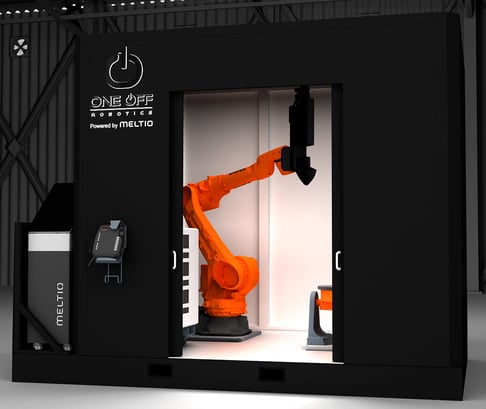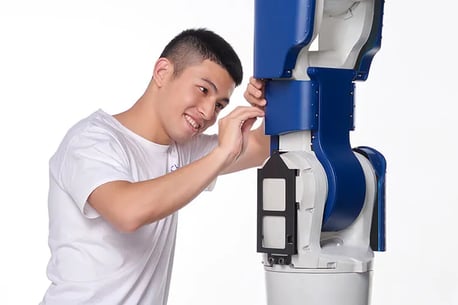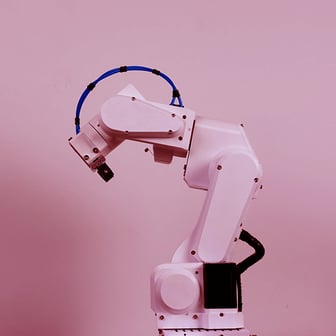News briefs for the week take a look at the new trend in manufacturing called microfactories—where robots rule, a first-ever, ready-to-use 3D printing cabinet, T-skin safety sheathing for cobots and industrial robots, and a do-it-yourself 3D printed cobot for desktop production.
Microfactories: Where robots rule!

Are microfactories the future of manufacturing? There’s a factory automation trend that’s just beginning to take hold that deviates radically from the standard assembly line, especially those in auto plants. Korea’s Hyundai has built such a totally different auto plant for its electric vehicle production (EV) in Singapore.
The Hyundai plant is made up of pods or cells where 60% of the manufacturing of the Ioniq 5 EV is accomplished by robots (see video); the remaining 40% is completed by human workers alone or in partnership with robots.
The net-net when it comes to employees is that it utilizes only 100 workers to produce 30,000 vehicles a year. In pod assemblies, robots rule!
Alpesh Patel, VP of Innovation at Hyundai, thinks that a microfactory’s cell production method could well be standard in a few years. Overall cost reduction to manufacture is 50% less than a traditional or fully custom automated line. “This is because modules use 70% of the same components (frame, power, safety, conveyor system).” Plus, development and assembly time is typically 50% less than a fully automated custom line.
“In the cells” writes Suvrat Kothari, “robots install components of a car, before moving to the next zone. The key differentiator is that the cells can be programmed with specific instructions, right from installing components for different variants of the same car, or to working on a completely different model. Traditional assembly lines would need significant retooling for similar adaptability.”
The cells are linked together by a common conveyor and feeder system, capable of providing high volume, high mix production capability.
Modular automation can scale up or down easily. “Depending on the complexity of the product or sub-assembly, manufacturers can easily expect to get 3-4k units’ per hour (UPH), or 1 million units a month.”
Ready-to-use 3D printing robot
Market need: Ready-to-use, turn-key system providing an efficient, fast, and safe solution for manufacturing metal 3D printed parts,  especially with stainless steel, nickel, and titanium. To meet the need, Spain’s Meltio and US-based One Off Robotics partnered for the production of a self-enclosed 3D printing cabinet.
especially with stainless steel, nickel, and titanium. To meet the need, Spain’s Meltio and US-based One Off Robotics partnered for the production of a self-enclosed 3D printing cabinet.
Meltio is a manufacturer and developer of wire-laser metal 3D printing technologies, and One Off Robotics is a builder of robotic arm fabrication systems for additive, subtractive, and hybrid manufacturing processes.
In combining their technologies, they claim a first-ever, turn-key solution to provide industries with an efficient additive manufacturing work cell named the One Off Robotics Cell. According to Meltio Product Manager, Alejandro Nieto, “This new hardware system allows the customer to receive a ready-to-use cell for robotic metal 3D printing, removing the integration process and long assembly lead times.”
With a deposition rate of up to 1 kg an hour, this system produces fully dense parts that are mechanically equivalent or superior to those created from traditional means.
The One Off Robotics Cell seamlessly integrates control of the system, allowing the user to easily adjust settings for quick printing. Its 8-axis system simplifies printing of complex geometries and is configured to work with the Meltio Space robotic slicer.
Safety skin stops robots instantly
Keeping workers safe from cobots has always been a concern; more so with cobots than standard industrial robots, which are usually segregated from workers by fencing or walls.
In 2016, FANUC introduced contact-sensing cobot safety padding which were polyurethane foam pads applied to the exterior of cobot arms. Stopping time in 2016 was 9 milliseconds.
 Nearly ten years on, Taiwan-based Touche Solutions (formerly named Mechavision) has recently developed a contact-sensing film of safety material that’s also applied to the exterior of not only cobot arms but also to those of industrial robot arms. Called T-skin, it has a stopping time of 1 millisecond. Want to know how long a millisecond is? Check out the video below.
Nearly ten years on, Taiwan-based Touche Solutions (formerly named Mechavision) has recently developed a contact-sensing film of safety material that’s also applied to the exterior of not only cobot arms but also to those of industrial robot arms. Called T-skin, it has a stopping time of 1 millisecond. Want to know how long a millisecond is? Check out the video below.
Touche Solutions’ founder and chairman, Camus Su, and general manager, Liu Changhe, are graduates of the Industrial Technology Research Institute (ITRI). Their collaboration in 2017 led to Touche Solutions, which emphasizes “tactile sensing technology to trigger emergency stops in robots, serving as a crucial safety measure beyond visual and light grids.”
The founders claim that T-Skin, was developed based on the ISO standard unit of 10 newtons (1kgf) that triggers emergency stops in response to an external force of 1 kilogram, within 1 millisecond, and is unaffected by either electromagnetic waves or RF.
A primary aim of Touche Solutions is “to outfit traditional industrial robots with collaborative (cobot) capabilities, which has garnered quick recognition from leading Japanese robotics companies (FANUC, Kawasaki, etc.).
All of this means that industrial robots can now, with the addition of T-skin, take on jobs formerly meant only for cobots working in and around people.
DIY 3D printed desktop cobot
Got a small-shop business with lots of desktop production needs? Need a solid educational cobot arm for learning projects? Want to market and sell cobots online to a global audience? Introducing the award-winning PAROL6 (Source Robotics).
 Roboticist Petar Crnjak is hoping to bring industrial-style robot arms to a wider audience with an open-source 3D-printable six-axis design dubbed the PAROL6 — offering support for an impressive 2.2lbs (1kg) payload.
Roboticist Petar Crnjak is hoping to bring industrial-style robot arms to a wider audience with an open-source 3D-printable six-axis design dubbed the PAROL6 — offering support for an impressive 2.2lbs (1kg) payload.
Crnjak says his “PAROL6 is a high-performance, 3D-printed desktop robotic arm, with a design approach similar to ” of his creation. “The design approach of PAROL6 was to be similar “to industrial robots in terms of mechanical design, control software, and usability. Control software, GUI (Graphical User Interface), and PAROL6’s STL files are open source.” Aside from a pneumatic gripper, each axis is driven by a stepper motor, with at least a few of these axes being driven through a metal planetary gearbox for extra precision and torque.
Depending on ones’ level of expertise, PAROL 6, with access to a 3D printer and online design specs (free), it can be a DIY project; it also comes in kit form; or purchased ready to go straight out of the box for $3.200 (3,000 euros).
“By pairing industrial mechanical design with state-of-the-art software and electronics, the PAROL6 robot can achieve smooth motions, high speeds, and high repeatability. PAROL6 is built with education, research, and small automation in mind!”





GIPHY App Key not set. Please check settings